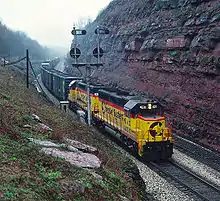Sand Patch Grade
Sand Patch Grade is an approximately 100-mile-long (160 km) section of railroad track known for its steep grades and curves through the Allegheny Mountains of Pennsylvania and Maryland.[1] Dropping over 1,000 feet (300 m) in about 20 miles (32 km) and with grades as much as 2%,[2] Sand Patch Grade is one of the steepest railroad grades on the East Coast.[3]

Sand Patch Grade was originally built by the Pittsburgh & Connelsville Railroad (P&C) to connect Pittsburgh and Connellsville, with an extension authorized to Cumberland, Maryland in 1853. [4] The extension required a crossing of the Allegheny Mountains via a 4,777-foot-long (1,456 m) tunnel, which was constructed between 1854 and 1871.[5] At the time, this project was one of the longest tunnels in the United States.[6] It was designed for two tracks but, due to difficult terrain and inconsistent geology, the plan was revised to one track.[5] Work on the tunnel was beset with problems – embezzlement, contractor bankruptcy, the Civil War, and political battles – so that the tunnel was only worked on for 8 of the 17 years it was technically under construction.[5][7] Ventilation in the tunnel was a problem; four vertical shafts had been bored during construction, and three were finished to provide air circulation.[5] By 1900, sky-rocketing traffic on the line necessitated a tunnel with higher capacity.[5][8]
A new 4,475-foot-long (1,364 m) double-track tunnel on a shallower grade and improved alignment was constructed between 1911 and 1913.[9] It has two concrete-lined vertical ventilation shafts to supply air.[10] The original one-track tunnel was retained for a time after the two-track tunnel was completed,[8] temporarily providing three tracks at that point on the line.[10] The old tunnel was abandoned in 1917 and is now flooded and collapsed in places.[11]
In 2001, the 'SA' Tower near the western portal of the tunnel was decommissioned and demolished.
The P&C eventually became the Pittsburgh Division of the Baltimore & Ohio Railroad (B&O), which became a component of the Chessie System in 1972, then was merged into CSX in 1987. The line is now part of the Keystone Subdivision, an East-West main line operated by CSX Transportation. Passengers can ride over Sand Patch Grade on Amtrak's Chicago-Washington train, the Capitol Limited.
Mance, Pennsylvania, along the Sand Patch Grade is a popular spot for railfans and photographers due to the horseshoe curve located there, as well as the scenic backdrop provided by the old general store and tree farm. The line is also popular as a place to watch the trains labor up the steep grade.[2]
Further reading
- History of the Sand Patch Tunnel at Abandoned
References
- "Welcome to The Sand Patch Guide at HIGH IRON Online". Ihavideo.com. 2001-09-11. Retrieved 2016-04-02.
- "Sandpatch". Trainz Pro Routes. Retrieved 2016-04-02.
- Jones, Sally (2010). "Sand Patch". Meyersdale, PA. Meyersdale Area Historical Society. Archived from the original on 2012-09-09.CS1 maint: bot: original URL status unknown (link)
- Cridlebaugh, Bruce (2008). "Railroad History, Pittsburgh Plan, 1923".
- Roberts, Charles S. (2005). Sand Patch: Cumberland to Connellsville and Branches 1837-1993 (Second ed.). Baltimore, Maryland: Barnard, Roberts and Co., Inc. p. 70. ISBN 0-934118-20-5.
- Historic American Engineering Record (HAER) No. PA-375, "Sand Patch Tunnel"
- Roberts 2005, pp 20-21.
- Brown, Scott C. (1992), "Sand Patch Tunnel, Baltimore and Ohio Railroad, HAER No. PA-375" (PDF), Historic American Engineering Record, Washington, D.C.: Library of Congress, retrieved January 29, 2014
- Roberts 2005, pp 71-72.
- "Work on the Sand Patch Tunnel, B & O". The Excavating Engineer. Milwaukee, Wisconsin: The Excavating Engineer Publishing Company. 9 (1): 369–373. October 1912. Retrieved 15 October 2017.
- Muller, Christopher. "Sand Patch Tunnel (1871-1917)". Abandoned Railroad Tunnels. SteamPhotos.com. Retrieved 2016-04-02.